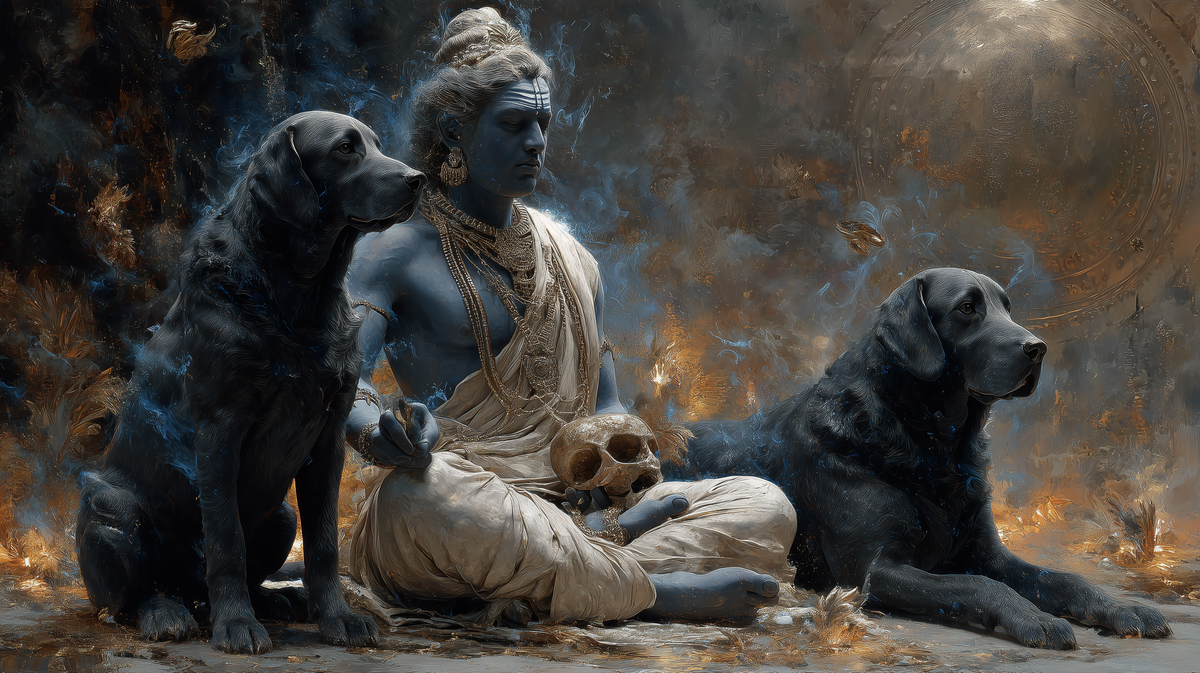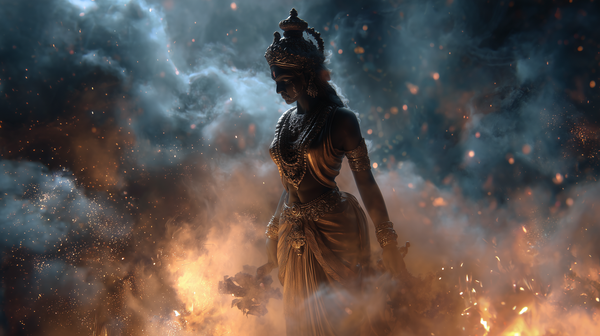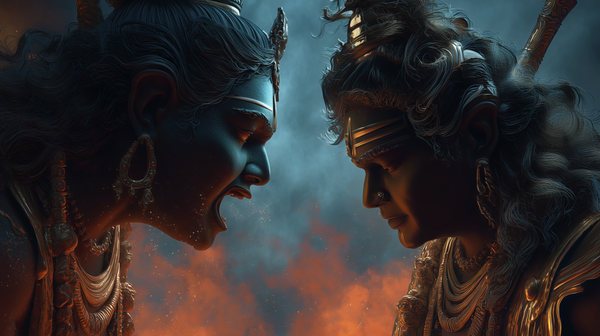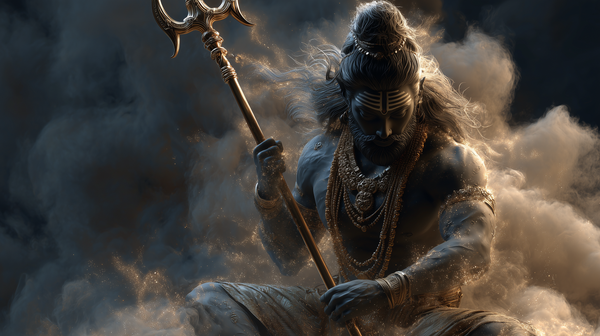Bhairava Sadhana: Dogs in Sadhana - Before the Basics Part 2
In the digital age, Bhairava offers a uniquely accessible path to tantric practice, welcoming sincere devotees regardless of formal initiation or traditional lineage.

This article is derived from Guruji’s video lecture, Satsang, Praveen Radhakrishnan. All content and intellectual property rights belong to Guruji and the KaliPutra Mission
The Democratization of Spiritual Knowledge
[00:00:09] In today's digital age, virtually every mantra, stotra, and ashtakam for any deity is readily available online. The technical knowledge that once required years of study in traditional guru-kulas is now accessible to anyone with internet access. This accessibility doesn't diminish the power or value of these sacred practices—what has changed is the traditional system itself.
[00:01:09] The traditional guru-kula system has weakened considerably. While some institutions maintain ancient values, many have been compromised by individuals lacking spiritual caliber. Simultaneously, spiritually gifted individuals often pursue materialistic goals, returning to spirituality only in retirement when they lack the time to properly progress through traditional hierarchies. This shift means that many current spiritual leaders may not possess the depth of knowledge and realization we might hope for.
Breaking Down Spiritual Elitism
[00:02:10] Unlike previous eras when Sanskrit literacy was limited to certain social classes, today most people can read English, Hindi, and regional languages. Sanskrit mantras transliterated into English are accessible to all, requiring only occasional oral guidance for specific pronunciations. This democratization of knowledge represents a fundamental shift in spiritual accessibility.
[00:03:06] A crucial warning against spiritual arrogance emerges here: claiming that mantras have lost their power due to non-traditional learning methods, or that someone is unworthy because they learned from the internet, constitutes "Papa Karma" (sinful action). The deities are not weak—they respond to sincere devotion regardless of how one acquires the knowledge. When someone "puts his heart and soul and time and effort and bleeds for that mantra," the divine responds.
[00:04:01] This is particularly true for Bhairava, who "resides in procedural collapse"—present where traditional rules and procedures break down. Those who mock sincere practitioners, especially in Bhairava upasana, may find their own lives "spiraling out of control" within 30-40 days. Bhairava recognizes and rewards innocent devotion over procedural perfection.
The Unique Nature of Bhairava
[00:04:52] Bhairava's approach to devotees differs fundamentally from other deities. He doesn't follow standard invocation processes—if he likes you, he will "pick you out... make you sit in front of him and he will teach you." This direct intervention means that those without gurus shouldn't feel dejected or inferior. In fact, some self-taught practitioners may progress as quickly or even surpass those with formal initiation.
[00:05:45] In this Kali Yuga, where exemplary gurus are rare and traditional knowledge systems have degraded, Bhairava offers a unique path. For those blessed with a worthy guru, cherish that relationship. For those without, don't panic—Bhairava himself can become your guide if approached with sincere intent.
[00:06:37] Bhairava represents an ideal starting point for spiritual practice because he embodies "all the shakti of Kali Yuga but in a child form." This makes him "easier to digest" regardless of one's spiritual background—whether you've practiced for decades or just begun visiting temples. His child-like form (Batuk Bhairava) is simultaneously the "least risky" and "highest rewarding" approach to tantric practice.
Practical Instructions for Beginning Practice
[00:07:27] To begin Bhairava sadhana, start with these simple steps:
- Find and print a pleasing, serene photograph of Bhairava from the internet
- Choose a consistent daily practice time (sunset is ideal, though sunrise or evening hours work too)
- Set up in a dark room with a lit lamp
- Offer something simple like jaggery water or fruits
[00:08:26] Begin with the most basic mantra—simply "Om" while visualizing Bhairava. This alone, practiced consistently for a year, can yield tremendous progress. Alternatively, use "Om Shri Kala Bhairava Namaha" as a slightly more elaborate option. The key is consistency, not complexity or volume.
[00:09:24] Bhairava doesn't count mantras or compare devotees based on quantity. He comes to everyone who approaches him innocently. As the "Guru Tattva within Shiva," he embodies pure love and compassion. Your first experiences with him will reveal this compassionate nature—but only if approached without pride or pretension.
The Path of Innocence and Rapid Progress
[00:10:19] Approach Bhairava with childlike innocence, not with credentials or lineage pride. Tell him simply: "My goal is to reach you. I am a fool. I know only one thing but I have to reach you. I want you to acknowledge me. I want to come to you." With this attitude, "blindly start walking towards him."
[00:11:04] For focused practitioners, initial experiences may come within three months. These include synchronicities, meaningful connections, and signs placed "like a treasure hunt" for you to discover. This early phase of recognition and discovery represents "a very fun-filled stage of sadhana."
The Sacred Role of Dogs in Bhairava Practice
[00:11:45] Dogs perfectly embody Bhairava's accessible nature. As the speaker notes while surrounded by Rajapalayam dogs, these animals represent "the most innocent creatures" with simple, loyal hearts. Feed a dog once, and it will follow you "till the end of your destination"—this loyalty and innocence perfectly reflects how Bhairava relates to his devotees.
[00:12:08] Dogs represent dharma itself, inhabiting both cremation grounds alongside crows and the grandest temples. They are "the most easiest to please," which is precisely why they serve as Bhairava's vahana (vehicle). Their simplicity mirrors Bhairava's own directness—he "sprouted out" from Shiva in rage, declaring "I'm going to give the knowledge and I don't want even the Creator between me."
Integrating Dogs into Daily Practice
[00:13:50] Include dogs in your daily worship by keeping biscuits or dog food alongside your offerings to Bhairava. After completing your prayers (mantras, 108 names, optional ashtakam, kavacham, shatanamavali, and kshama prarthana), maintain complete silence. Take the food set aside for dogs, walk outside, and feed stray dogs in your vicinity while mentally invoking Bhairava. Then return home without speaking to anyone.
[00:15:34] This practice yields "very fast results" because dogs, recognizing you as a provider, "will wish wonders for you." Their simple gratitude becomes a powerful blessing. Dogs function as "living, breathing yantras of Bhairava"—when they see Bhairava within you, that divine presence grows stronger.
Essential Warnings and Deeper Understanding
[00:16:33] In any Shaiva path, vahanas (divine vehicles) like cows, bulls, and dogs play crucial roles. Including them in sadhana leads to "miraculously fast progress." However, being fearful or hateful toward dogs creates "an inbuilt code that probably there will be problems in your sadhana."
[00:18:27] Never view yourself as superior to dogs or feel special because they're drawn to you. They approach "for a reason"—they recognize something divine within you. Treat them with respect, ensure they're well-fed and cared for. Disrespecting or allowing dogs to suffer while practicing Bhairava sadhana constitutes a serious spiritual transgression.
Navigating Karma and Spiritual Progress
[00:19:59] Learn to navigate karma without complaint. When you see karma unfolding, recognize "you have earned it" from past and present actions. Moving toward Bhairava helps "burn karma faster." Continuously request the shakti (power) to accelerate this process while praying never to accumulate fresh negative karma.
[00:20:54] As you progress, dogs will increasingly recognize Bhairava within you. When the vahana visualizes the deity in you, "the Bhairava within you grows"—this is how you truly embody divine presence.
The Balance of Simplicity and Power
[00:21:17] Most Bhairava mantras and procedures are freely available online. The key is not to overcomplicate—Bhairava is "anti-complication" by nature. He exists beyond procedures, having "sprouted out" in defiance of cosmic order itself. Overcomplication only creates distance from him.
[00:21:31] As you advance in Bhairava upasana, you'll inevitably feel Shakti's presence and may need to incorporate her worship. While Bhairava grants material benefits, his supreme gift is "knowledge of moksha, knowledge of burning karma, knowledge of relief from the cycle of life and birth." For worldly desires, approach Shakti—together, they "work really beautifully."
A Final Caution on Advanced Practices
[00:22:53] Regarding beeja mantras and advanced practices, proceed cautiously. These cause "very fast acceleration in your karmic burning," which can overwhelm unprepared practitioners and "cause havoc in their daily life." Start simple, progress gradually, and let Bhairava himself guide your advancement. The path he offers is simultaneously the most accessible and the most profound—requiring only sincere devotion, consistent practice, and an open heart.
Glossary
- Bhairava Sadhana/Upasana: Spiritual practice or worship dedicated to the deity Bhairava.
- Mantra: A sacred utterance, a numinous sound, or a syllable, word or phonemes, or group of words in Sanskrit, Pali and other languages believed by practitioners to have religious, magical or spiritual powers.
- Stotram/Ashtakam: A type of hymn or devotional poem, typically praising a deity.
- Guru Kulas: Traditional schools or residences where students lived and learned from a guru (spiritual teacher).
- Sadhana: A spiritual discipline or practice undertaken to attain a specific goal or level of spiritual realisation.
- Diety/Deities: A god or goddess; a divine being.
- Kaliyuga: The last of the four stages the world goes through as part of the cycle of Yugas described in the Indian scriptures. It is considered the present epoch, characterised by moral and spiritual decline.
- Satya Yuga: The first and most virtuous of the four Yugas.
- Gyan/Gyana: Knowledge, especially spiritual knowledge or wisdom.
- Vahana: The vehicle or mount of a deity. In this context, the dog is Bhairava's vahana.
- Smashan: A cremation ground or cemetery, often associated with certain forms of deities like Bhairava.
- Upasana: Worship; sitting near or attending upon a deity or guru.
- Arati/Aarti: A ritual performed as part of a puja, involving the waving of lamps before a deity.
- Anushthan/Anusthan: A religious ceremony, ritual, or penance, often involving chanting a specific number of mantras.
- Malas: A string of beads used for counting mantras during meditation or prayer. One mala typically contains 108 beads.
- Nadia: An offering of food or other items to a deity, which is then distributed to devotees as blessed remnants.
- Kavacham: A protective hymn or mantra.
- Kshama Prarthana: A prayer seeking forgiveness for any mistakes made during the puja or sadhana.
- Viddhi/Vidhi: A procedure, method, or ritualistic rule.
- Shaiva Path: The path of spiritual practice dedicated to the deity Shiva and his various forms, including Bhairava.
- Yantras: Mystical diagrams or symbols, often used in tantric practices.
- Karma: The sum of a person's actions in this and previous states of existence, viewed as deciding their fate in future existences.
- Moksha: Liberation from the cycle of death and rebirth; spiritual salvation.
- Shakti: Divine feminine energy; the dynamic power of the universe; often personified as a goddess.
- Shakti Upasana: Spiritual practice or worship dedicated to Shakti.
- Beeja Mantras: Seed syllables or mantras, often considered powerful and concentrated forms of sound energy.




